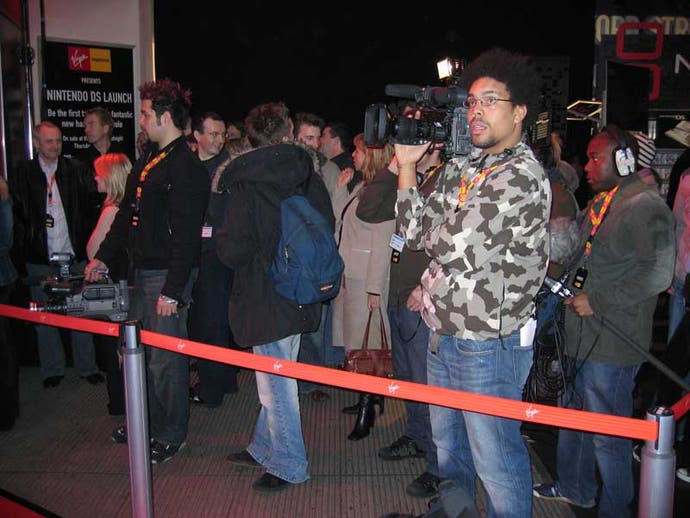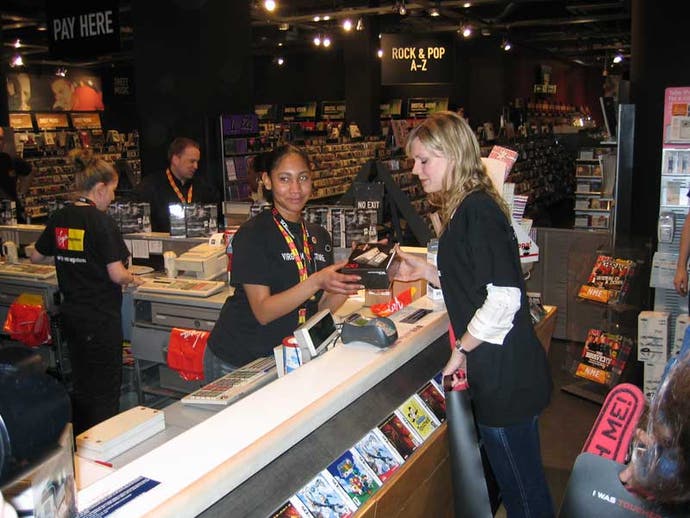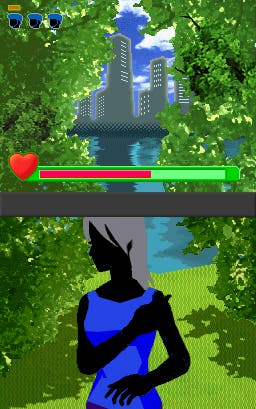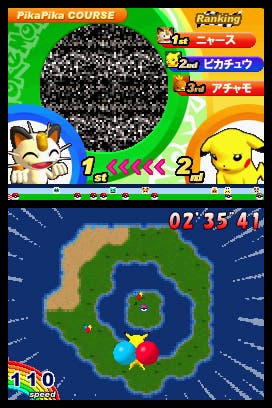Nintendo DS launches in Europe
An overview of the system, a look at the 16-strong launch line-up, and links to all our reviews and shots.

Nintendo DS is available in Europe today, priced £99 with a line-up of 15 or 16 launch titles depending on where you live priced between £20 and £30.
It's strange to think it's only been 13 months since it was originally unveiled, but stranger still to think it received such a dismissive response. A quick read back over the comments thread on our coverage of the original announcement reveals that a great many readers - many of whom have been pretty loyal to Nintendo over the years in spite of everything - were seriously unimpressed by the idea of a dual screen console. Indeed, some of our less charitable respondents said it was the worst idea ever, commercial suicide, and the death knell for Nintendo.
One extremely memorable E3 conference later and the tone had changed significantly. PlayStation Portable was at E3 2004, but there are plenty - us included - who would argue that the DS owned the show. Some of us were urging caution in the face of a lot of impressive technical demonstrations but rather few solid concepts that felt like they could amount to a whole game, but it was hard not to get lost in the hyperbole: here was a console that developers were coming out of the woodwork to get on board with because it was so unconventional. We came away with a lot of thoughts, but two stood out: firstly, developers were openly enthralled by the versatility and creative focus of this thing's design and plainly wanted to work on it with nary a money hat in sight; secondly, we'd been insane to put up with the plainly underpowered GBA for so long. (Not that the latter point stopped it selling units by the truckload for the rest of the year, mind. It never does.)

By the time the system launched in the US in late November, it was far from the "Shite" it had originally been declared by a lot of forum-goers in January. The dual screens were sensibly sized, the touch screen robust and responsive, the stylus well kept, the buttons pretty well distributed, the size and weight of the thing surprisingly comfortable, the list of games as long as your arm and the technical gubbins and service potential far greater than any other handheld. Not only could it display N64-quality visuals - without the blur - on both screens simultaneously, and last for around 10 hours on one battery charge, with a proper sodding back light after years of pleading, but it had all sorts of wireless functionality, single-cartridge wireless multiplayer, the possibility of downloadable wireless demos (currently trialling in Japan) and even backwards compatibility with the GBA. It even features a 16-user picture and text wireless chat service. The only thing it couldn't do was let us play our old monochrome GB copy of Tetris, as the GBA slot only supported GBA carts. We weren't enormously upset, to be honest - and you won't be either if you explore the various puzzle titles on offer for the new machine.
Naturally it hasn't all been positive. The shoulder buttons should perhaps click directly downward, SNES shoulder pad style, more than slope (although the PSP's sticky alternatives arguably led us all to forget about this), while the praise the D-pad won for being larger ("Aha, it now supports the human hand," was pretty much the first thing we said when we got it home) was tempered somewhat by the slightly clicky nature of it. Still, then we spotted the microphone input, which distracted us, and then we found the headphone port and cried little tears of joy. The DS was a fully formed, fully featured Nintendo console, and suddenly we wanted to hug Ken Kutaragi for giving the Kyoto massive a kick up the backside. And it's not often we want to hug Ken Kutaragi. There was, like, only that one time.
Those of you who still haven't quite got your heads round the technology and design of the unit, we suggest checking out our first impressions of the handheld from November. The US model should be almost indistinguishable from its European sibling, and we can assure you that games from all territories work on all units. We're already playing UK-published DS games on our US and Japanese units. And, as it comes time to consider buying it or not, it's the games that everyone wants to know about. Fortunately, we've played all the important ones. Here's what you'll find when you go down to the shops today to take a peek.
The Launch Line-up

Metroid Prime: Hunters - First Hunt (Nintendo/NST)
A game that we don't need to sell to you, this, as this particular demo comes free in every box. Effectively it's a training programme - introducing you to the first-person shooter genre on the stylus-driven handheld, with several control options to choose between - but it also features wireless multiplayer support for up to four players. And while it's not revolutionary, nor a particularly ideal way to tackle a first-person shooter, it does demonstrate potential - and it will certainly occupy you for a few hours as you tinker with your brand new toy. At least until you can find the fingernails to get the cellophane off some of these other beauties.
Full first impressions.
Super Mario 64 DS (Nintendo)
Unquestionably the flagship title, worryingly - and a little hypocritically given Nintendo's mounting rhetoric about originality and new concepts - it's an N64 port with a few extra bits and bobs. Fortunately, the N64 game in question is one of the finest 3D platformers ever produced, and the DS handles it almost wonderfully, with only a few camera and control issues occasionally blighting the experience. Control is obviously something it takes time to get the hang of, but the method of using the stylus to control a sort of on-screen analogue zone to marshal Mario's movement speed is ingenious, and it quickly becomes pretty intuitive. And unlike the Super Mario Advance series on GBA, which has always been thoroughly exciting and depressing at the same time, this is a proper update, with 30 new stars to find, multiple characters to control (who you'll have to rotate through in order to reach certain stars), and a raft of mini-games that arguably represent more of a timesink in the end than the single-player platform mode itself. Oh, and there's a fairly throwaway wireless multiplayer mode. It's a bit of a must-have, regardless of whether you played Mario 64 years ago or never before.
Full review and extended discussion.
Wario Ware Touched! (Nintendo/Intelligent Systems)
After screaming at you lot to buy the GBA version of Wario Ware when that came out, it's given us enormous pleasure to see Wario Ware's DS outing treated with such respect by its masters - despite its commercial failings in the West. Heck, some say the entire system was designed to take advantage of its barrage of quick-sharp five-second microgames, which involve slicing fruit one minute, drawing a symbol the next, tearing at scratch panels, and far more. What was slightly less pleasurable however was, ironically, the game itself. Although we've played only the Japanese version at this point, we weren't as overawed by it as we were the GBA original (or the tilt sensor equipped GBA sequel Wario Ware Twisted!, for that matter). None the less, it's still a striking game, full of inventiveness and hugely entertaining, and a lot of our postbag on the subject has been along the lines of "It's not quite as good, sure, but I'm still playing it constantly." So it seems you'll have fun. And, as we read back over our Japanese import review, it's actually all we can do to stop ourselves sliding it back into the DS cartridge port for an hour, cosying back up under the bedsheets and pretending we slept through our alarm.
Japanese import review (European review to follow).

Project Rub (SEGA/Sonic Team)
Known as I Would Die For You in Japan (where it took on a more RPG-ish slant, says Rob) and by the gloriously unhinged moniker of Feel the Magic: XY-XX in the States, the game we're calling Project Rub in Europe was the first DS mini-games package we got to play and involves completing various stylus and microphone-based tasks to try and win the affections of a young lady. By, er, clicking feverishly on a rampaging bull, pulling scorpions off her back and trying to force things through a snake's intestines. (Does a snake have intestines? We should be told!) Although we came away feeling that it could have done more to hold our attention, it was unmistakably SEGA - brutally hard in some areas, incredibly arcade-y and with lots of unlockables and harder modes to master. And, frankly, home to some of the best and best-executed mini-game ideas on the system - most notably things like the unicycling-over-planks-between-skyscrapers bit (which is a virtual buzzbar, really) and, probably our favourite, a mini-game that involves directing one of four cats to meow conspicuously so that security guards will turn the other way and your friends can sneak past. Certainly not Rub-bish, unlike that pun.
Full review.
Mr. DRILLER: Drill Spirits (Namco)
An extremely simple game that this writer is extremely bad at but was barely able to stop playing at the time. It's not that far removed from regular Mr. Driller - you tunnel through blocks trying not to get crushed or run out of air, questing after a certain depth to clear the stage. Indeed, it's actually easier to play using the D-pad and A button than it is the stylus. But thanks to the addition of a clever Drill Spirits mode, it lasted a lot longer. Drill Spirits is Mr. Driller being chased by a lunatic in a big spiky metal machine, and the idea is to descend as quickly as possible and take him down using laser blasts whenever he exposes his own weaponry. It's absolutely manic, and a completely different style of play to the main Driller mode. With the addition of the Drill Shop on top of that to open up plenty of extras, Namco's puzzling debut on the DS becomes something of a must-have. It's one of those that you'll either get or you won't (unlike games like Zoo Keeper, which have a more universal appeal) but if you take to it we can imagine it lasting long in the cartridge slot.
Full review.
Zoo Keeper (Ignition/Success)
In case you haven't already noticed, yours truly has had a change of heart on this one and re-examined it today to coincide with its European launch. The idea here is to rotate little square animal-face icons to form lines of three or more (lines, not lions; though often lions, actually) so they'll disappear and more will drop down. You're working against a countdown and it's incredibly engrossing. What we didn't give it enough credit for originally, however, was its supplementary modes, which really add a huge amount to the proposition and ultimately mean that it's our most played and most loved of all the DS launch titles - despite a slightly shaky start.
Original review and today's reappraisal.

Pokémon Dash (Nintendo)
Another first party title, Pokémon Dash seems to have done well in the Japanese charts, but badly in the ratings. In essence it's an on-foot Pokémon checkpoint-based racing game where track layouts are outlines of characters, amongst other things. Fair enough, you might argue - wasn't that Yoshi outline track one of our favourite efforts in the whole of Mario Kart: Double Dash!! Yes, yes, but we're still not sold. Definitely one we'd advise waiting for the review on, this.
Screenshots.
Polarium (Nintendo)
This, meanwhile, is one that we're just going to go out and buy for ourselves regardless of whether Nintendo sends out a copy or not. It's another addictive-sounding puzzler and this time the concept couldn't be much simpler: you draw lines to convert white squares to black squares. Completed lines will disappear. And you want to try and use as few stylus strokes as possible. If that doesn't sound like something magically simple to you, then we suggest buying Tetris on eBay and starting at the beginning. It's going to be a long education. We've read enough and heard enough positive testimonials from our electronic friends to be confident that this is worth spending our hard-earned on, and you probably should be too. Expect a review very soon.
Retro Atari Classics (Atari/Taniko)
Kristan normally writes about these retro game compilations, but since he's busy swanning around San Francisco at the moment doing the whole "roving reporter" lark at the Game Developers Conference, it seems fair to reward his bastard-ish-ness by stealing the review copy of Retro Atari Classics that turned up yesterday. Oh, oh, some of you are still on his side, eh? Okay, let's address that. You know those LCD TVs that were given out before one of the keynotes? He won one. So, now we're all in agreement that yours truly had every right to steal the only copy of the game we have, how about some info? It includes versions of Centipede, Tempest, Pong, Warlords, Missile Command, Breakout, Sprint, Gravitar, Asteroids and Lunar Lander, you can play them in classic or enhanced versions, it features four-player wireless support and most of the games are played using a stylus. Breakout and Pong both involve sliding your paddle along the bottom of the touch-screen, for example, with both splitting action between top and bottom. It seems like fun, and naturally we'll be giving you a full rundown within a few days.
Screenshots.

And The Rest
The other games on the DS launch line-up have met with less enthusiasm than some of the above, and we're not going to preach about them at great lengths because in several cases we haven't seen them ourselves yet. However, of them, we are confident that Rayman DS can build on its underrated 3D platform performance of late. He'll prove us wrong now.
Elsewhere though, Spider-Man 2 is likely to perform well, though we'd suggest trying before you buy where possible; The Urbz is fundamentally a Sims game and will therefore appeal to anybody who fancies wiling away a commute being bored at home instead; Asphalt Urban GT has been derided, sadly, as we could do with a great racer (which Ridge Racer DS, not out today for some reason, certainly isn't either); Ping Pals bizarrely seems to be a more colourful version of the built-in PictoChat software, with a few mini-games thrown in; platform title Robots is apparently dreadfully dull; and although our screenshots of Sprung say, "Come with me and I promise you won't be disappointed," the raft of terribly low scores suggests otherwise. Still, there were bound to be some turkeys in a 16-strong launch line-up.
Perhaps most disappointing though is comment from the US that suggests Tiger Woods PGA Tour hasn't managed to live up to the potential it's been fulfilling on home consoles for a few years now. Without the analogue stick control system, apparently it suffers. Naturally we're keen to test this for ourselves, and will let you know just as soon as we do what we think of it.
Launch Stations
(Just not PlayStations, at this point.) For more coverage of the Nintendo DS European launch, check out our coverage of the system's midnight launch in London. And, of course, expect more and more DS coverage on Eurogamer as it starts to make its mark in Europe.

